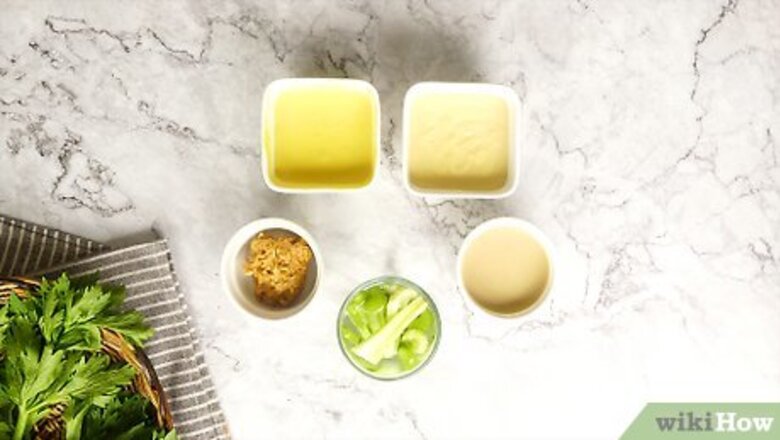
views
X
Research source
In this article, we’ll show you the best ways to prep celery for snacking and some delicious dips and dishes to try it with. Let’s take a look!
Best Dipping Sauces for Raw Celery
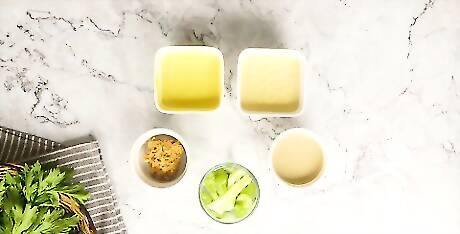
Dip celery into any number of sauces. Celery has a mild, watery flavor that blends well with most things. Experiment with your favorite soups, dips, sauces, and butters, and see what keeps you coming back for more. If you aren't sure whether a particular sauce will go well with the flavor of celery, dip a small chunk of celery in and see how you like it. It never hurts to try.

Try dipping your celery sticks in hummus. This thick, garbanzo-bean based dip has been used in Mediterranean and Middle-Eastern cuisine for centuries, and it's the perfect compliment to the Mediterranean-grown celery. You should be able to find pre-packaged hummus in most grocery stores. Plain hummus is great, but it can also come mixed with garlic, eggplant, red peppers, avocado, and other ingredients. Experiment with other Middle Eastern sauces, such as tahini (a sesame seed dip) and toum (a garlic paste). Be aware that these dips tend to taste stronger and saltier than standard hummus.
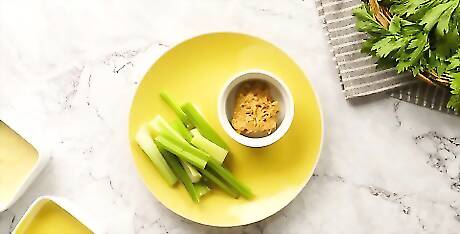
Consider dipping celery in peanut butter. This is a classic move, and it's a great way to add protein to your snack. Most peanut butter is thick enough that you can spread it directly onto the celery stick. Choose chunky or smooth peanut butter, to your preference. You can find peanut butter in most U.S. grocery stores, and some stores allow you to grind your own from fresh nuts. Spice up this classic choice by using other types of nut butter: almond butter, cashew butter, or walnut butter, for instance. These are more difficult to find in stores, but many upscale healthy-food retailers may offer them. Make "Ants on a Log": Pimp out your peanut-butter celery stick with raisins, seeds, or even M&Ms. This is a great way to make celery exciting for kids.
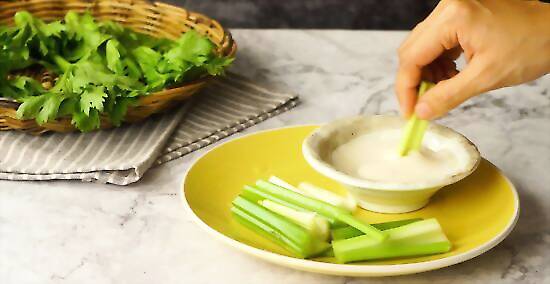
Dip celery in salad dressing. Ranch is a popular choice, but any creamy dressing will do: thousand island, blue cheese, Italian, Caesar, etc. Serve the dressing in a small bowl or tray for easy access. Be judicious; you can always pour more!
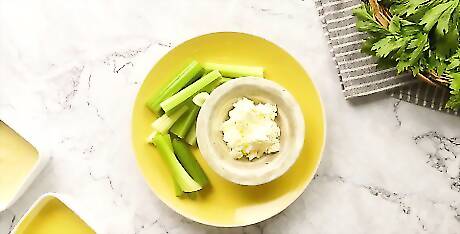
Try dipping celery in yogurt or cream cheese. Greek or plain yogurt may blend most smoothly with the flavor of the celery, but feel free to experiment with other flavors. Plain cream cheese is fine, but consider trying any number of herbed or flavored cream cheese dips.
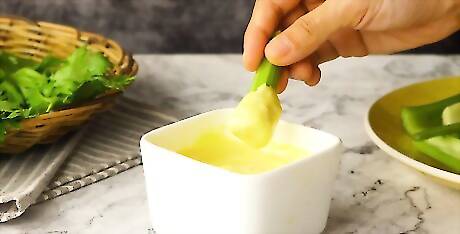
Try dipping celery in cheese sauce. Fondue, nacho cheese, or any melted cheese sauce will do. You may be able to find cheese sauce in some grocery stores; but consider making your own fondue.
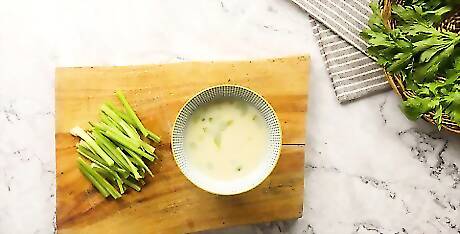
Dip celery in soup. This works best with creamy soups: clam chowder, potato leek soup, or even celery soup itself. You can use celery as a low-calorie replacement for saltine soup crackers or oyster crackers. Celery will not absorb soup in the same that crackers do, but the grooved channel in the stalk will provide a scooping mechanism. Keep 3-4 inch long chunks alongside your soup for scooping, or chop the celery directly into the soup.
Cooking Meals & Side Dishes with Celery

Make celery soup. Celery soup is a warming autumn and winter dish that's easy to make and goes well with bread. You'll need a head of celery; an onion; 15 grams (1/2 ounce) of butter, margarine, or olive oil; 900mL (1&1/2 pints) of vegetable stock or water; salt and pepper to taste.

Make stewed celery. This is a quick, simple side-dish that can complement larger, meatier entrees. You can stew celery with olive oil, wine, and white sauce, among other things.
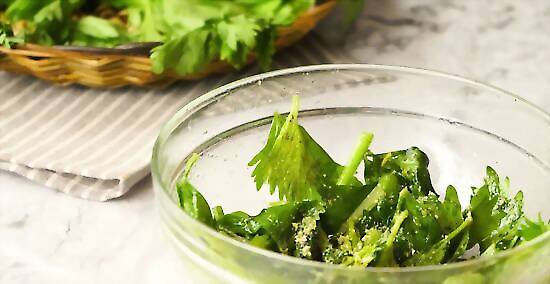
Chop celery into a salad. Many recipes explicitly ask for celery (e.g. potato salad), but feel free to add it raw to any salad. You can also make it the star of a salad--for instance, consider making a lemon, celery, and Parmesan salad: In a medium bowl, toss 4 thinly-sliced stalks of celery, 1/4 celery leaves, 2 tablespoons of extra-virgin olive oil, 1/2 teaspoon of finely grated lemon zest, 1 teaspoon of fresh lemon juice, and 1/4 teaspoon each of salt and pepper. Gently toss the mixture with one ounce of Parmesan cheese. Serve cold or at room temperature.
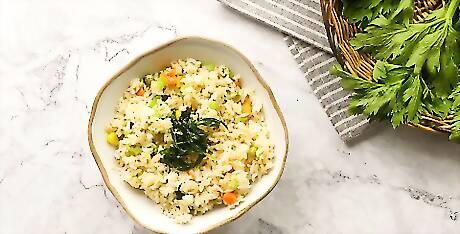
Cook celery in a stir-fry. Celery adds a unique flavor and texture to mixed-vegetable stir-fries, and it goes well with many rice- and pasta-based Asian and Mediterranean dishes. Chop celery stems into bite-sized portions to cook. Keep the leaves whole, and treat them like any other leafy green: they cook quickly, so add them in later than the other vegetables. Celery is 75% water, and the rest of its bulk is stringy and fibrous--so it does not need to cook for long. Do not expect the stems to change much when cooked. although they may soften and become less chewy.
Buying & Storing Celery
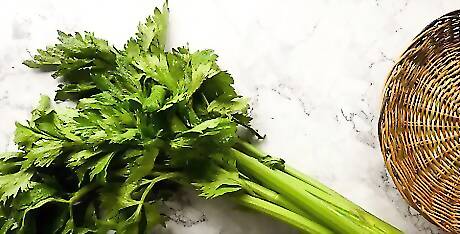
Buy fresh celery. You can find celery at most grocery stores and farmers markets, and you may also encounter it in some gardens. For the freshest celery, consider buying a locally-grown product. You can find pre-packaged celery, but it may have been shipped from who-knows-where, stored for who-knows-how-long, and sprayed with who-knows-how-many pesticides. Buy a whole stalk of celery. Make sure that the stalk is light green, firm, and unblemished. If the stalk is whitish, soft, or cracked it may be going bad; if the leaves are wilted, choose a fresher stalk. If you're looking for a quick and convenient snack, consider buying a package of pre-cut celery sticks. Again, pre-packaged sticks may not be as fresh as whole-stalk, locally-grown celery, but they take less work to prepare if you're in a hurry.
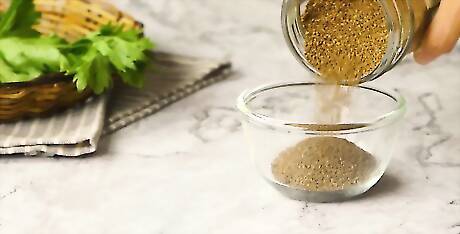
Consider growing celery. Celery is a Mediterranean plant, and it grows best in temperate climates with temperatures between 59 and 70 degrees Fahrenheit. Celery is a long-season crop, and it may be difficult to grow in areas with brief summers. The seeds sprout best when they are sprouted indoors. You should be able to find a package of celery seeds at a local nursery or garden-supply store. You may be able to harvest wild celery seeds; refer to botanical field guides, or ask a friend who grows celery in her garden. If you grow your own celery, you can collect the seeds and use them as seasoning. With care and planning, you can ensure that you will have a consistent supply of celery from year to year.
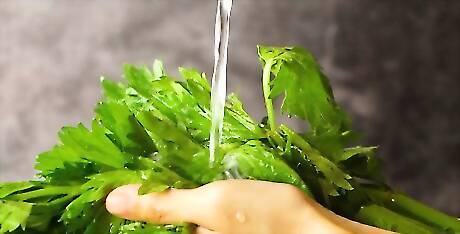
Wash your celery. Use fresh, running water, but don't use soap or detergent. There's a chance that commercially-grown celery has been sprayed with pesticides and other chemicals, and a thorough rinsing can remove many potential contaminants. Washing can also reduce the risk of contracting any number of food-borne illnesses.
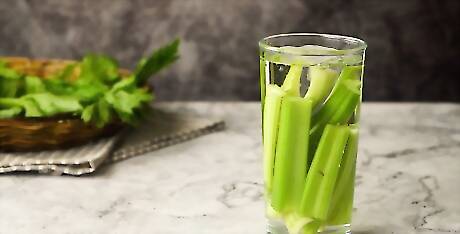
Store celery in the refrigerator until you're ready to use it. You may store celery in the crisper drawer, in a well-sealed plastic bag, or in a bowl or jar with the end of the stalk submerged in a bit of water to keep it fresh. When properly stored, fresh (whole) celery should last 3-4 weeks past the printed sell-by date; pre-packaged celery should last 2-3 days past the printed date; and cooked celery should last up to one week after it is cooked. Celery is not always sold with an expiration date. Use your intuition: if the stalk is whitish, soft, cracked, or wilted, it may be going bad. If you won't use your celery before four weeks have passed, consider freezing it and thawing it out when you need it.

Chop the stalk into pieces, to taste. If you buy a whole, fresh stalk of celery, cut off the leaves at the top; compost the leaves or put them out with the trash. If you will be dipping the celery into a sauce or condiment, chop the stalk into pieces ranging from 3–4 inches (7.6–10 cm) in length. If you are cooking with celery or mixing it into a salad, chop it into smaller, bite-sized pieces, or dice it finely.

















Comments
0 comment